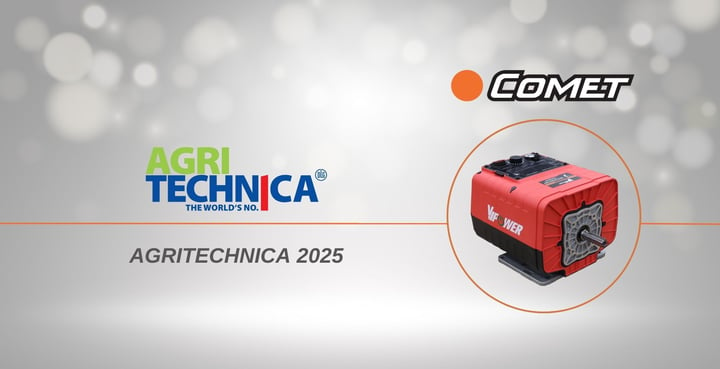Greenhouses, by their very nature, take advantage of the sun but they equally need shade and shading is achieved through special products called, precisely, shading agents.
Comet has identified the most suitable solution for the application of these products in the high-pressure diaphragm pumps of the historic APS series, with appropriate modifications we will explain in this article..
GREENHOUSES
Among the various possible applications and numerous uses in agriculture, diaphragm pumps are also used in the greenhouse treatment.
READ ALSO: 3 MAJOR ADVANTAGES OF USING A DIAPHRAGM PUMP AS AN AGRICULTURAL PUMP
Greenhouses are structures built to create an artificial environment specifically designed for the cultivation of plants and flowers to recreate their natural habitat; likewise, they are made to dry agricultural products.
The advantage mainly offered is to grow, even in colder climates, those plants that usually proliferate in very hot or tropical climate zones. Conversely, with the refrigerated greenhouses, those products that are native to cold areas or that fear excessive heat are grown, even in hot countries.
Built with metal, wooden or masonry structures, greenhouses are always distinguished by transparent walls and covers - glass or plastic - which allow light to penetrate and, through openable windows, regulate internal ventilation.
The working principle is precisely that of the greenhouse effect: the sun’s rays are trapped by the coating and raise the temperature inside the greenhouse, insulating the crop from the outside weather.
In addition to a number of structural features, greenhouses are mainly divided, depending on the achievable temperature, into:
- Propagation or multiplication greenhouses, for rooting flowering and fruit plants
- Forcing or cultivation greenhouses, for growing leaf and flowering plants
- Ordinary crop greenhouses, for growing vegetable plants
- Drying greenhouses for drying agricultural, forestry and biomass products
GREENHOUSE SHADING
The exponential rise in temperature is, as we have seen, the main objective of a greenhouse. At the same time, however, especially in those countries where high temperatures are naturally reached during the summer season, it is important to keep the greenhouses shaded, in order to prevent the temperature inside from rising so high that simple airing cannot lower it, thus risking “burning” the crop.
Shading greenhouses allows reducing water supply and avoids physiological disturbances to crops by keeping temperatures below the critical threshold.
An issue that is growing and worsening especially with recent uncontrolled climate change phenomena. There are several methods for shading greenhouses, starting with mechanical methods such as textile screens: basically, fabric tarps that, however, have to be assembled and disassembled close to the critical time period, leading to high costs for purchase, installation, storage and disposal. The same applies to the application of rigid screens.
Therefore, liquid or powdered shaders, such as calcium carbonate, are much more practical and effective.

SHADING WITH CALCIUM CARBONATE
Shading agents, therefore, are key products for greenhouse cultivation, as they protect crops from excessive irradiation and, when applied on multiple greenhouses or in tunnels, allow cooling the environment inside the greenhouse due to their high shielding and heat-reflecting features.
Given the limitations already stated regarding mechanical methods, we can state that the most commonly used shading agents are liquid or powdered calcium carbonate products. In fact, this material, when applied directly on the roof of greenhouses, in addition to having a strong covering power, is not harmful to the environment as it is free of pollutants and has the peculiar characteristic of being self-degrading.
After its application, in fact, it carries out a slow natural degradation that coincides, according to accurate estimates, with the period when critical irradiation goes down, causing the greenhouse to return to its maximum radiating potential.
This application is very popular in Spain, where high temperatures combined with very restrictive laws about the use of toxic and environmentally harmful substances dictate the use of a natural shading agent that is both highly effective.
The widespread benefits of using calcium carbonate in agriculture as a sustainable and environmentally friendly element are well known. It’s a true fundamental element for plant development: it improves the mechanical strength of plant tissues, strengthens the lamellae of cell membranes and balances the uptake of potassium, magnesium, ammonium and sodium.
Therefore, calcium carbonate is used as a fertilizer for both agricultural and floristic soils, without any fear of polluting effects: of completely natural origin, it is obtained by extraction or crushing carbonate rocks into larger or smaller granules, depending on the destination.
Beyond these uses, therefore, its use as a liquid shading agent is especially popular.
APS PUMPS FOR CALCIUM CARBONATE
Special APS series diaphragm pumps are used to apply calcium carbonate shading agents.
READ ALSO: DIAPHRAGM PUMPS, WHAT THEY ARE AND HOW THEY WORK
In fact, diaphragm pumps are mainly used in agriculture for spraying and weed control due to their high mechanical-chemical resistance and to chemicals.
Given the growing demand in the Spanish market, Comet has therefore designed a new series of high-pressure pumps, derived from the historic APS series, dedicated to shading inside greenhouses using calcium carbonate products.
The valves in this range have been specially modified using top-quality hardened steels to resist the abrasive power of calcium carbonate.
In addition to the complete pump, a specific valve kit is also available to transform a standard pump into a calcium carbonate pump.














